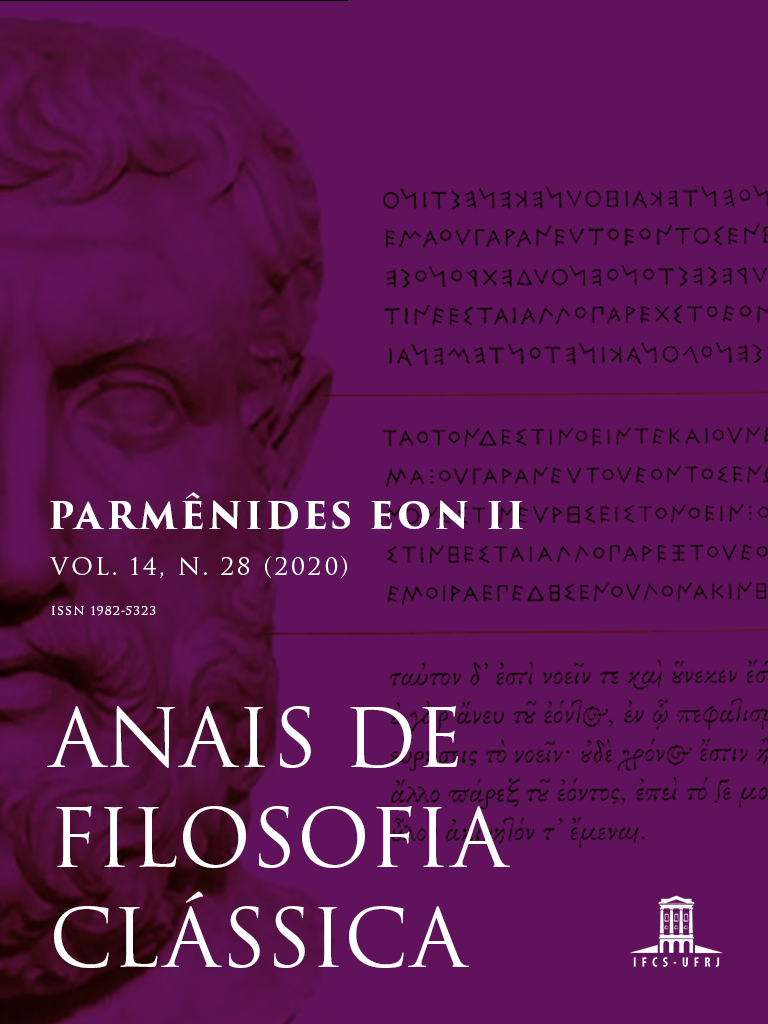Parmenides on Knowing What-is and What-is-not
DOI:
https://doi.org/10.47661/afcl.v14i28.38781Palavras-chave:
descriptive metaphysics, revisionary metaphysics, knowing, learning, thinking, testing, discovery, signs, what-is, what-is-not, elenchos, sêma, oida, gignôskô, manthano, punthanomai, noeô, Aristotle, Homer, ParmenidesResumo
Parmênides se apresenta ao seu público como alguém que alcançou um profundo discernimento da natureza de to eon ou “o-que-é”. Para sustentar essa posição ele efetuou um elenchos ou “prova” dos caminhos de inquérito disponíveis para pensar, identificando e depois usando, durante o processo, um conjunto de sēmata ou “signos” informativos. A esse respeito, Parmênides falava a linguagem da descoberta que ouvira na antiga poesia grega. Do mesmo modo, sua afirmação de que nós não podemos nem aprender e nem conhecer o-que-não-é (logo, não devemos dizer ou pensar “não é”) era justificada pelo sentido comum dos antigos verbos gregos para aprender e conhecer. De maneira impressionante, a metafísica revisionista de Parmênides se apoiava em grande medida na visão amplamente compartilhada daquilo que pode ser aprendido, conhecido e tornar conhecido a outros.Referências
Works Cited
Bicknell, P. J., “Parmenides, Fragment 10,” Hermes 96 (1968) 629-631.
Burkert, W., “Das Proömium des Parmenides und die Katabasis des Pythagoras,” Phronesis 14 (1969) 1-30.
Coxon, A. H., The Fragments of Parmenides (Las Vegas, Zurich, and Athens: Parmenides Publishing, 2009).
Curd, P., The Legacy of Parmenides (Princeton: Princeton University Press, 1998; reprinted Las Vegas, Zurich, and Athens: Parmenides Publishing, 2004).
Darcus, S., “-phrôn Epithets of thumos,” Glotta 55 (1977) 178-82.
Diels, H. and W. Kranz, Die Fragmente der Vorsokratiker. 6th edition, 3 volumes. (Berlin: Weidmann, 1951-52).
Gallop. D., Parmenides of Elea (Toronto: University of Toronto Press, 1984).
Johansen. T., “Parmenides’ Likely Story,” Oxford Studies in Ancient Philosophy 50 (2016) 1-29.
Kahn, C., “The Thesis of Parmenides,” The Review of Metaphysics 22 (1969) 700-724.
Kirk, G., J. Raven, and M. Schofield, The Presocratic Philosophers. 2nd edition (Cambridge: Cambridge University Press, 1983).
Lesher, J., “Parmenides’ Critique of Thinking: The poludêris elenchos of Fr. 7,” Oxford Studies in Ancient Philosophy 2 (1984) 1-30.
Lesher, J., “The Significance of kata pant’ atê in Parmenides Fr. 1.3,” Ancient Philosophy 14 (1994) 1-20.
Liddell, H. and R. Scott, A Greek-English Lexicon, rev. H. Jones and R. McKenzie, with the 1968 Supplement, 9th edition (Oxford: Oxford University Press, 1976). [Cited as LSJ]
Lyons, J., Structural Semantics (Oxford: Blackwell Publishing, 1963).
McKirahan, R., “Signs and Arguments in Parmenides B 8” in P. Curd and D. Graham (eds.), The Oxford Handbook of Presocratic Philosophy (Oxford: Oxford University Press, 2008), 189-229.
Mourelatos, A. P. D., The Route of Parmenides. Revised and expanded edition (Las Vegas, Zurich, and Athens: Parmenides Publishing, 2008).
Renehan. R., Review of Coxon 1986 in Ancient Philosophy 12 (1992) 395-409.
Rijksbaron, A., The Syntax and Semantics of the Verb in Classical Greek (Amsterdam: J. C. Gieben, 2002).
Strawson, P., Individuals: An Essay in Descriptive Metaphysics (London: Methuen and Co. Ltd., 1959).
Sullivan, S., “Kradiē, Ētor, and Kēr in Poetry after Homer,” Revue belge de Philologie et d’histoire 73 (1995) 17-38.


